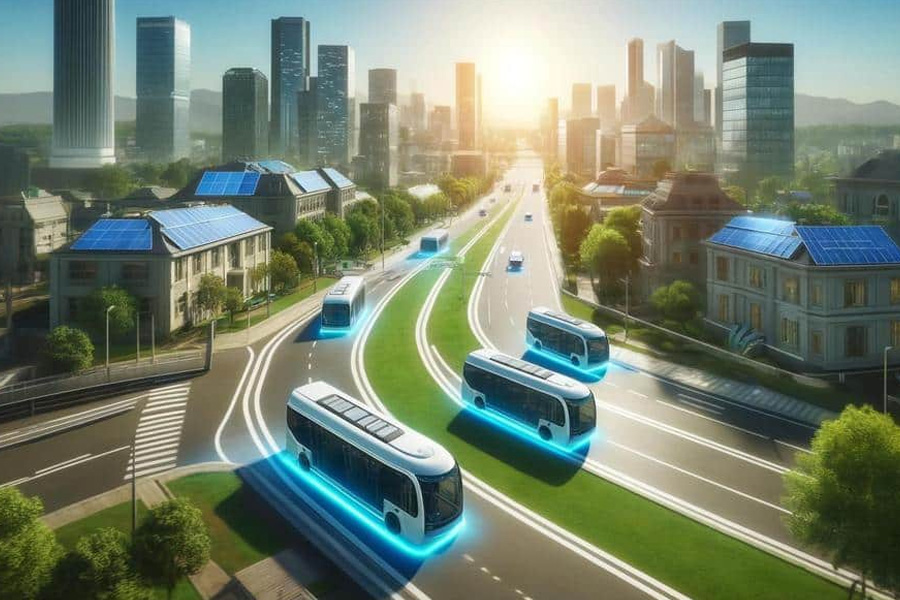
Image Source: www.intelligentliving.co
As urban areas continue to grow and develop, challenges in mobility and environmental sustainability become increasingly prominent. Sonoran Desert Institute (SDI), accredited by the Distance Education Accrediting Commission (DEAC), offers an Environmental Science course that introduces students to foundational concepts related to population growth and environmental considerations. The institute provides students with a broader understanding of environmental factors that influence various technological applications, including aspects of urban development.
The future of public transportation lies in the integration of green technologies, smart systems and innovative transit solutions that make commuting more sustainable and convenient. As cities prioritize reducing emissions and improving residents’ quality of life, advancements in transit systems are playing a key role in making urban areas more efficient, livable and eco-friendly.
Advancements in Public Transportation: Electric Buses, Autonomous Trains and Hyperloop Technology
Electric buses are rapidly becoming a cornerstone of sustainable urban transportation. Unlike traditional diesel-powered buses, electric buses produce zero emissions and operate more quietly, reducing noise pollution in urban areas. Many cities are already adopting electric buses as part of their strategy to create cleaner transportation networks. These buses are equipped with cutting-edge battery technology that allows for longer ranges and faster charging times, making them an increasingly viable option for public transit systems. As cities transition to electric buses, they are not only improving air quality but also contributing to efforts to combat climate change by reducing the overall carbon footprint of urban transit.
Another innovation in public transportation is the development of autonomous trains. Autonomous or self-driving trains use advanced sensors, AI and machine learning to navigate tracks without the need for human intervention. These systems offer several advantages, including increased safety, reduced operating costs and improved efficiency. Autonomous trains can operate more frequently and at higher speeds, helping to alleviate congestion on busy transit lines. Furthermore, AI-driven systems can optimize train schedules, ensuring that trains arrive and depart at the most efficient times, ultimately providing passengers with a more seamless and reliable transit experience.
Perhaps one of the most exciting advancements in public transportation is the emergence of hyperloop technology. Hyperloop is a high-speed, low-pressure transportation system that uses magnetic levitation to propel capsules through tubes at incredible speeds. While hyperloop technology is still in the early stages of development, it has the potential to improve urban mobility by offering ultra-fast, energy-efficient travel between cities.
With speeds of up to 700 miles per hour, the hyperloop could dramatically reduce travel times between major urban centers, making it possible to commute long distances in a fraction of the time it currently takes using conventional transportation methods. The development of hyperloop systems could help reduce the reliance on traditional forms of transportation, such as cars and airplanes, thereby decreasing congestion and emissions.
Smart Ticketing, Real-Time Tracking and AI-Driven Transit Optimization
In addition to advancements in vehicle technology, smart systems are improving how cities manage public transportation. Smart ticketing is one such innovation that is making it easier for passengers to access transit services. Using digital platforms, passengers can purchase and store tickets on their smartphones, eliminating the need for paper tickets or physical transit cards. Smart ticketing also allows for contactless payments, which improves convenience and reduces queues at stations. As more cities implement these systems, passengers can enjoy a faster and more efficient way to access transit services, helping to streamline the commuting experience.
Another key development in modern transit systems is real-time tracking. With real-time tracking technology, passengers can access live information about train, bus or tram schedules through mobile apps or digital displays at stations. This system improves the overall transit experience by providing accurate updates on delays, arrivals and departures, reducing the uncertainty that passengers often face when using traditional public transport. Real-time tracking also enables better coordination across various transit modes, making it easier for commuters to switch between buses, trains and trams as needed.
The Role of Public Transit in Reducing Urban Congestion and Improving Air Quality
One of the most pressing challenges facing cities today is urban congestion. As populations grow and more people flock to urban centers, the demand for transportation increases, often leading to traffic jams, long commute times and pollution. Public transportation offers a sustainable alternative to private car use, helping to alleviate congestion and reduce the number of vehicles on the road. By providing efficient and reliable transit options, cities can encourage residents to choose public transport over driving, ultimately reducing traffic congestion and improving the flow of goods and people in the city.
Reducing congestion and improving public transportation is essential for improving air quality in cities. Transportation is one of the largest contributors to air pollution, particularly from the emissions of private vehicles. By transitioning to electric buses, autonomous trains and other low-emission transit solutions, cities can significantly reduce harmful pollutants, such as nitrogen oxides and particulate matter, that contribute to respiratory issues and climate change. Public transit is also more energy-efficient than private car use, helping cities reduce their overall energy consumption and carbon emissions.
At Sonoran Desert Institute, students gain practical experience in drone operations, flight testing and FAA Remote Pilot Preparation. While its curriculum does not specifically cover AI, IoT or electric transit systems, the knowledge acquired in UAS technology can be applied to various aspects of modern transportation and smart city initiatives.
The future of public transportation lies in innovations that make urban mobility more sustainable, efficient and accessible. From electric buses and autonomous trains to hyperloop technology, these advancements are reshaping how we move within cities and between urban centers. The integration of smart ticketing, real-time tracking and AI-driven optimization is enhancing the commuter experience and improving the efficiency of transit systems. By reducing urban congestion, lowering emissions and providing more accessible transit options, public transportation can continue to play a vital role in making cities more livable and sustainable. As these innovations unfold, cities worldwide are poised to benefit from cleaner, more efficient and technologically advanced public transit networks.

